Devonian charophyte whorls of branches
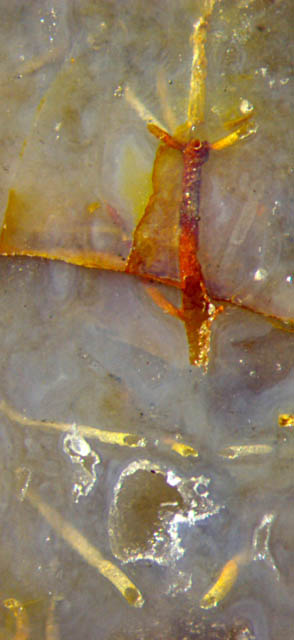 The
vain search for gyrogonites of Palaeonitella
has puzzled some palaeobotanists for decades [1]. Unexpectedly, new
finds gave rise to the suspicion that Palaeonitella did
not grow the typical individual gyrogonites at all but oogonia by the
dozen on
slender stalks: Rhynie
Chert News 73.
The problem of missing gyrogonites
had been there because the smooth-walled oogonia had not been noticed
or not
been recognized
as such. Judging
from own experience, they may be easily mistaken for something else: Rhynie
Chert News 138.
The
vain search for gyrogonites of Palaeonitella
has puzzled some palaeobotanists for decades [1]. Unexpectedly, new
finds gave rise to the suspicion that Palaeonitella did
not grow the typical individual gyrogonites at all but oogonia by the
dozen on
slender stalks: Rhynie
Chert News 73.
The problem of missing gyrogonites
had been there because the smooth-walled oogonia had not been noticed
or not
been recognized
as such. Judging
from own experience, they may be easily mistaken for something else: Rhynie
Chert News 138.
The
images Fig.1-5 have been taken from one chert layer fragment where all
these charophyte specimens had grown essentially upright so that
a few of them are well seen on vertical cut faces of the sample
as impressive sections
with stem and branches. What is seen here as stem and branches at first
sight is only the interior cavity filled with water after the cell
content had decayed. Apparently the cuticle delayed the diffusional
influx
of silica so that there was no quick formation of silica gel and
chalcedony inside. The walls got covered with slowly grown glittering
quartz crystals within.
Later the water vanished. Remarkably, some of the plants
remained hollow up to now.
(Same scale for Figs.1-9.)
Figs.1-5: Charophyte (stonewort alga) in Rhynie chert, known as Palaeonitella, with
whorls of few branches.
Fig.1 (right): Charophyte, hollow, with parts of hollow stem
and
branches cut off. Image height 4mm.
Fig.2 (below left): Charophyte,
partially hollow and filled with quartz grains; small specimen below
right:
end of a
stem with
branches protecting the top. Image width 2.5mm.
Fig.3: Charophyte, hollow, with quartz on the walls. Image
width 1.5mm.
Fig.4: Charophyte with asymmetrically grown
whorls,
hollow, with quartz inside on the walls. Image width 1.5mm.
Fig.5: Charophyte, hollow, with
quartz on the inside
of the walls. Image width 2.5mm. Photograph by H. Sahm.

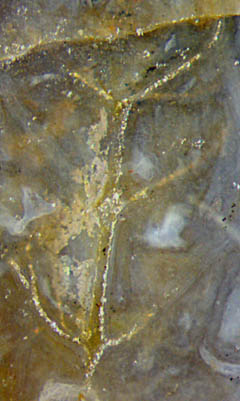
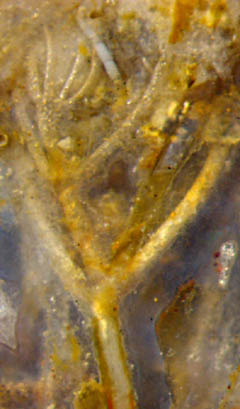
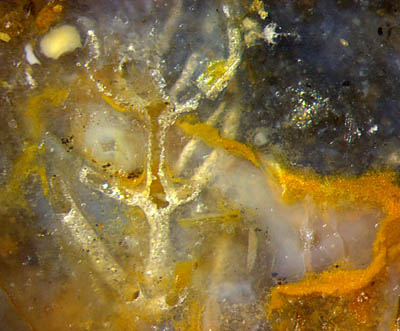
Even with branches and whorls cut off, Fig.1
makes a perfect
three-dimensional illusion so that it can be stated that there were
probably no more than 4 or 5 branches per whorl. This seems to be
confirmed by Figs.2-5 but there are a few whorls
with more branches hidden in this sample. Other
samples have provided
conspicuous whorl cross-sections with up to 11 branches
(Figs. 6-9).
Probably of no biological relevance is the fact that stems
and branches in Figs.1-5 are mostly hollow but those in
Figs.6-9 are not.
Figs.6-9 have been taken from specimens
distinguished by the presence of smooth-walled oogonia (discovered
in 2015, Rhynie
Chert News 139)
which implies the
absence of gyrogonites.
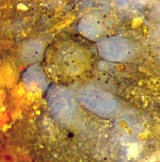
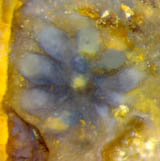
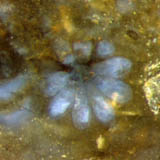
 Figs.6-8:
Charophyte whorl
cross-sections with up to 10 branches.
Width 1mm.
Figs.6-8:
Charophyte whorl
cross-sections with up to 10 branches.
Width 1mm.
Fig.9: Uppermost
charophyte whorl cross-section with 11 amber-coloured
upright branches and 12 (?)
smooth-walled
oogonia .
Width 1mm.
The problem is
stated but not solved
here: Do the specimens with
smooth-walled oogonia represent the assumedly well
known Palaeonitella
with
female organs not noticed before 2015, or do they indicate the
presence of a new charophyte species ? Anyway,
the discovery of multiple oogonia at the uppermost whorl is highly
relevant for the
charophyte Tree-of-Life possibly leading to the land
plants.
Samples: Figs.1-5:
Rh5/3 (0.6kg), found by
S. Weiss near Milton of Noth in 2001.
Fig.6:
Rh9/86 (0.28kg), found in
2003. Figs.7,8: Rh9/93 (0.6kg), found by S.W.
in 2011.
Fig.9: Rh10/42 (0.16kg), found by S.W.
in 2011.
H.-J.
Weiss 2021
[1] R. Kelman, M. Feist, N.H. Trewin, H. Hass :
Charophyte algae from the Rhynie chert,
Trans. Roy. Soc. Edinburgh,
Earth Sciences 94(2004 for 2003), 445-455.
 |
 |
169 |


 The
vain search for gyrogonites of Palaeonitella
has puzzled some palaeobotanists for decades [1]. Unexpectedly, new
finds gave rise to the suspicion that Palaeonitella did
not grow the typical individual gyrogonites at all but oogonia by the
dozen on
slender stalks: Rhynie
Chert News 73.
The problem of missing gyrogonites
had been there because the smooth-walled oogonia had not been noticed
or not
been recognized
as such. Judging
from own experience, they may be easily mistaken for something else: Rhynie
Chert News 138.
The
vain search for gyrogonites of Palaeonitella
has puzzled some palaeobotanists for decades [1]. Unexpectedly, new
finds gave rise to the suspicion that Palaeonitella did
not grow the typical individual gyrogonites at all but oogonia by the
dozen on
slender stalks: Rhynie
Chert News 73.
The problem of missing gyrogonites
had been there because the smooth-walled oogonia had not been noticed
or not
been recognized
as such. Judging
from own experience, they may be easily mistaken for something else: Rhynie
Chert News 138.







 Figs.6-8:
Charophyte whorl
cross-sections with up to 10 branches.
Width 1mm.
Figs.6-8:
Charophyte whorl
cross-sections with up to 10 branches.
Width 1mm.
